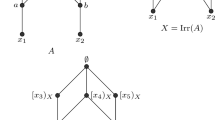Abstract
Motivated by Gentzen’s disjunction elimination rule in his Natural Deduction calculus and reading inequalities with meet in a natural way, we conceive a notion of distributivity for join semilattices. We prove that it is equivalent to a notion present in the literature. In the way, we prove that all notions of distributivity for join semilattices we have found in the literature are linearly ordered. We finally consider the notion of distributivity in join semilattices with arrow, that is, the algebraic structure corresponding to the disjunction-conditional fragment of intuitionistic logic.
Access this chapter
Tax calculation will be finalised at checkout
Purchases are for personal use only
Similar content being viewed by others
Notes
- 1.
A non-empty set I of a meet semillatice is called strong ideal if for any finite subset \(S \subseteq I\), it holds that \(S^{ul} \subseteq I\).
- 2.
Note that the original Hickman’s statement can be misleading since the condition “there exists \((x \wedge a_1) \vee (x \wedge a_2) \vee \cdots \vee (x \wedge a_n)\)” is missing.
- 3.
We thank the author of this PhD thesis for communicating this example.
- 4.
We thank the referee for pointing out this short proof.
References
R. Balbes, A representation theory for prime and implicative semilattices. Trans. Am. Math. Soc. 136, 261–267 (1969)
G. Bezhanishvili, R. Jansana, Duality for distributive and implicative semilattices. Preprints of University of Barcelona, Research Group in Non-Classical Logics (2008). http://www.ub.edu/grlnc/docs/BeJa08-m.pdf
I. Chajda, J. Rachůnek, Forbidden configurations for distributive and modular ordered sets. Order 5, 407–423 (1989)
I. Chajda, R. Halaš, J. Kühr, Semilattice Structures. Research and Exposition in Mathematics, vol. 30 (Heldermann Verlag, Lemgo, 2007)
I. Chajda, H. Länger, Relatively pseudocomplemented posets. Math. Bohem. 89–97 (2018)
G. Gentzen, Untersuchungen über das logische Schließen I. Math. Z. 39, 176–210 (1934)
L. González, Topological dualities and completions for (distributive) partially ordered sets. PhD Thesis, Universitat de Barcelona, 2015
G. Grätzer, Lattice Theory: Foundation (Springer/Birkhäuser, Berlin, 2011)
G. Grätzer, E. Schmidt, On congruence lattices of lattices. Acta Math. Acad. Sci. Hung. 13, 179–185 (1962)
R. Halaš, Pseudocomplemented ordered sets. Arch. Math. (Brno) 29, 153–160 (1993)
R. Hickman, Mildly distributive semilattices. J. Aust. Math. Soc. (Ser. A) 36, 287–315 (1984)
T. Katriňák, Pseudokomplementäre Halbverbände. Mat. Časopis 18, 121–143 (1968)
K. Kearns, The class of prime semilattices is not finitely axiomatizable, Semigroup Forum, vol. 55 (1997), pp. 133–134
J. Larmerová, J. Rachůnek, Translations of distributive and modular ordered sets. Acta Univ. Palacki. Olomuc. Fac. Rerum Nat. Math. XXVII(91), 13–23 (1988)
J. Rachůnek, A characterization of o-distributive semilattices. Acta Sci. Math. 54, 241–246 (1990)
B. Schein, On the definition of distributive semilattices. Algebr. Univers. 2, 1–2 (1972)
C. Serra Alves, Distributivity and wellfounded semilattices. Port. Math. 52(1), 25–27 (1995)
K. Shum, M. Chan, C. Lai, K. So, Characterizations for prime semilattices. Can. J. Math. 37(6), 1059–1073 (1985)
T. Skolem, Untersuchungen über die Axiome des Klassenkalküls und über Produktations- und Summationsprobleme, welche gewisse Klassen von Aussagen betreffen. Skr. Utg. Videnskapsselsk. Kristiania I Mat.-Naturvidenskabelig Kl. 3, 1–37 (1919)
T. Skolem, in Selected Works in Logic, ed. by J.E. Fenstad (Universitetforlaget, Oslo, 1970)
Acknowledgements
The authors thank the anonymous referee for his/her helpful comments. They also acknowledge partial support by the H2020 MSCA-RISE-2015 project SYSMICS. Esteva and Godo also acknowledge the FEDER/MINECO project RASO (TIN2015-71799-C2-1-P).
Author information
Authors and Affiliations
Corresponding author
Editor information
Editors and Affiliations
Rights and permissions
Copyright information
© 2021 Springer Nature Switzerland AG
About this chapter
Cite this chapter
Ertola-Biraben, R.C., Esteva, F., Godo, L. (2021). On Distributive Join Semilattices. In: Fazio, D., Ledda, A., Paoli, F. (eds) Algebraic Perspectives on Substructural Logics. Trends in Logic, vol 55. Springer, Cham. https://doi.org/10.1007/978-3-030-52163-9_3
Download citation
DOI: https://doi.org/10.1007/978-3-030-52163-9_3
Published:
Publisher Name: Springer, Cham
Print ISBN: 978-3-030-52162-2
Online ISBN: 978-3-030-52163-9
eBook Packages: Religion and PhilosophyPhilosophy and Religion (R0)




